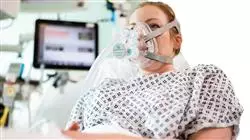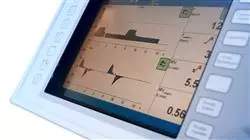University certificate
The world's largest faculty of medicine”
Introduction to the Program
The Postgraduate Diploma in NIMV in Specific Pathologies will allow you to learn the state-of-the-art techniques for adjusting ventilatory parameters in patients with COPD or EPID”

In recent years, the use of Non-Invasive Mechanical Ventilation to address respiratory difficulties with greater safety and less invasiveness for the patient has become increasingly common. This has led to the emergence of numerous studies focused on finding criteria for its application in different types of diseases and individuals, as well as the development of updated monitoring techniques to optimize patient follow-up. Given the significant benefits offered by these advances to ensure the proper treatment and recovery of patients, understanding them is essential for the physician who wants to stay up-to-date in their field.
For that reason, TECH has designed this Postgraduate Diploma, with the idea of providing the specialist with the most up-to-date aspects related to the application of Non-Invasive Mechanical Ventilation in different pathologies and in patients of different ages. Through 450 hours of intensive study, you will delve into the cutting-edge indications and contraindications of NIMV in adults with COPD, ARDS, Acute Hypoxemic Respiratory Failure, or individuals with Obesity. You will also deepen your knowledge of updated monitoring and adjustment techniques of Non-Invasive Mechanical Ventilation for children, as well as the pioneering strategies for monitoring individuals with chronic home ventilation.
All of this will be done through an excellent 100% online methodology, allowing the student to update themselves without the need for daily commutes to a study center. Likewise, you will have access to a series of top-notch educational content, which has been prepared by specialists in Pulmonology who work actively with Non-Invasive Mechanical Ventilation. Therefore, the knowledge acquired during the program will be in full harmony with the latest industry advances.
Through this certificate, you will deepen in the recent findings on the indications and contraindications of NIMV in Hypoxemic Acute Respiratory Failure”
This Postgraduate diploma in the NIMV in Specific Pathologies contains the most complete and up-to-date scientific program on the market. The most important features include:
- The development of case studies presented by experts in Non-Invasive Mechanical Ventilation
- The graphic, schematic, and practical contents with which they are created, provide scientific and practical information on the disciplines that are essential for professional practice
- Practical exercises where self-assessment can be used to improve learning
- Its special emphasis on innovative methodologies
- Theoretical lessons, questions to the expert, debate forums on controversial topics, and individual reflection assignments
- Content that is accessible from any fixed or portable device with an Internet connection
Through this program, you will delve into the sophisticated techniques of monitoring and adjustment of Non Invasive Mechanical Ventilation in pediatric patients”
The program’s teaching staff includes professionals from the field who contribute their work experience to this educational program, as well as renowned specialists from leading societies and prestigious universities.
The multimedia content, developed with the latest educational technology, will provide the professional with situated and contextual learning, i.e., a simulated environment that will provide immersive education programmed to learn in real situations.
This program is designed around Problem-Based Learning, whereby the professional must try to solve the different professional practice situations that arise during the academic year For this purpose, the students will be assisted by an innovative interactive video system created by renowned and experienced experts.
Position yourself as a cutting-edge pulmonologist in just 6 months, enjoying the best educational methodology on the market”

Update yourself 24 hours a day and from wherever you desire thanks to the 100% online format of this program"
Why study at TECH?
TECH is the world’s largest online university. With an impressive catalog of more than 14,000 university programs available in 11 languages, it is positioned as a leader in employability, with a 99% job placement rate. In addition, it relies on an enormous faculty of more than 6,000 professors of the highest international renown.

Study at the world's largest online university and guarantee your professional success. The future starts at TECH”
The world’s best online university according to FORBES
The prestigious Forbes magazine, specialized in business and finance, has highlighted TECH as “the world's best online university” This is what they have recently stated in an article in their digital edition in which they echo the success story of this institution, “thanks to the academic offer it provides, the selection of its teaching staff, and an innovative learning method aimed at educating the professionals of the future”
A revolutionary study method, a cutting-edge faculty and a practical focus: the key to TECH's success.
The most complete study plans on the university scene
TECH offers the most complete study plans on the university scene, with syllabuses that cover fundamental concepts and, at the same time, the main scientific advances in their specific scientific areas. In addition, these programs are continuously being updated to guarantee students the academic vanguard and the most in-demand professional skills. In this way, the university's qualifications provide its graduates with a significant advantage to propel their careers to success.
TECH offers the most comprehensive and intensive study plans on the current university scene.
A world-class teaching staff
TECH's teaching staff is made up of more than 6,000 professors with the highest international recognition. Professors, researchers and top executives of multinational companies, including Isaiah Covington, performance coach of the Boston Celtics; Magda Romanska, principal investigator at Harvard MetaLAB; Ignacio Wistumba, chairman of the department of translational molecular pathology at MD Anderson Cancer Center; and D.W. Pine, creative director of TIME magazine, among others.
Internationally renowned experts, specialized in different branches of Health, Technology, Communication and Business, form part of the TECH faculty.
A unique learning method
TECH is the first university to use Relearning in all its programs. It is the best online learning methodology, accredited with international teaching quality certifications, provided by prestigious educational agencies. In addition, this disruptive educational model is complemented with the “Case Method”, thereby setting up a unique online teaching strategy. Innovative teaching resources are also implemented, including detailed videos, infographics and interactive summaries.
TECH combines Relearning and the Case Method in all its university programs to guarantee excellent theoretical and practical learning, studying whenever and wherever you want.
The world's largest online university
TECH is the world’s largest online university. We are the largest educational institution, with the best and widest online educational catalog, one hundred percent online and covering the vast majority of areas of knowledge. We offer a large selection of our own degrees and accredited online undergraduate and postgraduate degrees. In total, more than 14,000 university degrees, in eleven different languages, make us the largest educational largest in the world.
TECH has the world's most extensive catalog of academic and official programs, available in more than 11 languages.
Google Premier Partner
The American technology giant has awarded TECH the Google Google Premier Partner badge. This award, which is only available to 3% of the world's companies, highlights the efficient, flexible and tailored experience that this university provides to students. The recognition as a Google Premier Partner not only accredits the maximum rigor, performance and investment in TECH's digital infrastructures, but also places this university as one of the world's leading technology companies.
Google has positioned TECH in the top 3% of the world's most important technology companies by awarding it its Google Premier Partner badge.
The official online university of the NBA
TECH is the official online university of the NBA. Thanks to our agreement with the biggest league in basketball, we offer our students exclusive university programs, as well as a wide variety of educational resources focused on the business of the league and other areas of the sports industry. Each program is made up of a uniquely designed syllabus and features exceptional guest hosts: professionals with a distinguished sports background who will offer their expertise on the most relevant topics.
TECH has been selected by the NBA, the world's top basketball league, as its official online university.
The top-rated university by its students
Students have positioned TECH as the world's top-rated university on the main review websites, with a highest rating of 4.9 out of 5, obtained from more than 1,000 reviews. These results consolidate TECH as the benchmark university institution at an international level, reflecting the excellence and positive impact of its educational model.” reflecting the excellence and positive impact of its educational model.”
TECH is the world’s top-rated university by its students.
Leaders in employability
TECH has managed to become the leading university in employability. 99% of its students obtain jobs in the academic field they have studied, within one year of completing any of the university's programs. A similar number achieve immediate career enhancement. All this thanks to a study methodology that bases its effectiveness on the acquisition of practical skills, which are absolutely necessary for professional development.
99% of TECH graduates find a job within a year of completing their studies.
Postgraduate Diploma in NIMV in Specific Pathologies
Discover the future of specialized medical care with our Postgraduate Diploma in NIV in Specific Pathologies in Specific Pathologies. TECH Global University invites you to take an opportunity to acquire the advanced knowledge and skills necessary to become an expert in the use of NIV in the treatment of specific pathologies, improving the quality of life of patients effectively and safely. Our online classes give you the flexibility to learn from anywhere and at any time, something fundamental in the health sector, because optimizing your time is a requirement to constantly advance. At TECH Global University, we understand the importance of accessibility and convenience in education, so we have designed an interactive and collaborative virtual environment that allows you to actively participate in the program and connect with other healthcare professionals.
There is no better place than TECH to advance professionally in the healthcare sector
In the Postgraduate Diploma in NIV in Specific Pathologies, you will explore the latest techniques and advances in noninvasive mechanical ventilation for the treatment of respiratory diseases and specific pathologies. You will learn how to properly assess patients, select the appropriate equipment and apply the most effective therapeutic strategies to improve their respiratory function and quality of life. Our team of NIV experts and healthcare professionals will guide you through this program, providing you with practical and up-to-date learning. Through clinical cases, simulations and interactive sessions, you will develop the skills necessary to manage different clinical scenarios and make informed decisions based on clinical experience. Upon completion of the program, you will earn a recognized certificate that will validate your knowledge and open doors to new career opportunities in the field of noninvasive mechanical ventilation. Don't miss the opportunity to advance in an ever-growing discipline and contribute to the well-being of patients. Enroll today in the Postgraduate Diploma in NIV in Specific Pathologies at TECH Global University and make a difference in specialized medical care!







